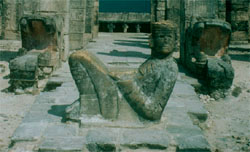|
HISTORY
 Throughout Chichén Itzá are reclining stone figures grasping platelike receptacles, called
chacmools
, which are purely Toltec in origin; these may have been used to receive the human hearts sacrificed to Chac. But the most important structure in this area is
El Castillo
, also called the Pyramid of
Kukulc
á
n
. During every spring and fall equinox, the late afternoon sun creates the appearance of a snake slithering down this structure.
Throughout Chichén Itzá are reclining stone figures grasping platelike receptacles, called
chacmools
, which are purely Toltec in origin; these may have been used to receive the human hearts sacrificed to Chac. But the most important structure in this area is
El Castillo
, also called the Pyramid of
Kukulc
á
n
. During every spring and fall equinox, the late afternoon sun creates the appearance of a snake slithering down this structure.
 The Fall of Chichén Itzá
The Fall of Chichén Itzá
The Toltec ruled at Chichén Itzá until approximately AD 1200, when the city was mysteriously abandoned. The city was then settled by the Itzá, a merchant and warrior people, around AD 1224, who gave the city its present name: Chichén Itzá means “at the mouth of the well of the Itzá.” These wells, or
cenotes
, circular sinkholes formed by underground caves collapsing, provided water for both drinking and agriculture. One well, the Sacred Cenote, was most likely a ceremonial center. Jade, engraved gold disks, and even human bones have been found inside it, leading many to believe that human sacrifices were offered at this spot.
 The Itzá abandoned Chichén Itz
á
almost immediately after they settled there, again, for reasons unknown, and settled in nearby Mayapan, which became the capital of the Yucatan for about two hundred years until warring factions set up separate city states. The glory of Chichén Itz
á
was never again realized; only the silent buildings remain to remind us of its former grandeur and of the sophisticated knowledge of the heavens the Maya possessed.
The Itzá abandoned Chichén Itz
á
almost immediately after they settled there, again, for reasons unknown, and settled in nearby Mayapan, which became the capital of the Yucatan for about two hundred years until warring factions set up separate city states. The glory of Chichén Itz
á
was never again realized; only the silent buildings remain to remind us of its former grandeur and of the sophisticated knowledge of the heavens the Maya possessed.
<--previous page
|

